Ankle-deep and frozen in the reed-stagnated shallows of Lake Michigan, Brian Pitser stood alert, deep-bagged net crossed valiantly over his shoulder. His eyes—hopeful, calculating, and resigned—scanned a backwater bay for answers. For fishy shapes, movement, and lumbering shadows. For carp.
His two aged clients stood to his side and slightly behind, simmering with anticipation. I trained my eyes on the water, trying to play clean-up with my gaze. Several moments passed, and no suggestion of carp came. Twisting his wading boots from the icy grip of the lake, Brian signaled our retreat, and the ongoing hunt for fish. He knows carp, and he knows the challenge they present to the angler.
A veteran of the waters of Grand Traverse Bay, and owner of The Northern Angler Fly Shop in Traverse City, Brian has been hunting the bay’s shallow edges and quiet backwaters for almost a decade. He knows—as well as anyone can—the subtleties of the presentation and hunt required to tie into what they call “golden bones” on the flats of the great lake. As the Commander-In-Chief of a staff of guides, he has taken it upon himself to lead carp trips in the summer months, when the flats absorb the hot sun, attracting warmth-seeking carp from the lake’s depths in hoards. This is the same season when the Hexes that dedicated Michigan trout hunters live and die by emerge, when the state’s largest brown trout lure their devotees down famous rivers in the night. Carp are harder and less-predictable. The other guides yield to Brian.
Though fickle beasts, comfort can be found in the ideal of finite mysteriousness. Carp, it can be said (as it can with other species), are carp, across their range. They all conform to the same biology-driven habits; they all, more or less, behave the same way.
We have carp in the South. Here they are associated with slow-moving beats of warm, dingy rivers; silty canals and ponds; and the surface of larger reservoirs, if you’re lucky enough to time and fish a periodical cicada hatch correctly.
More Like This
The differences between populations of fish—what they demand from the angler—are geographical. Perhaps this is why anglers (almost inevitably) find themselves intoxicated by the idea of angling travel at some point along their learning curves—flying, driving, or walking great distances to catch the same species they could at home, where the experience has become all too known. Seeking familiar faces in new, strange, and exciting locations, where there are secrets unknown.
Lucid Lake Michigan, it would seem, would be devoid of secrets, if not for its size. Shades of sapphire in total, looking straight down, a bottom-feeding carp, or one of the behemoth smallmouth the invasive gobies have subsidized, can be spotted at 60 feet. But there are still secrets. The carp keep them.
As we idled along, flanking a small island, Brian’s clients, Mat and Boyd, two regular trout fishermen and devoted Trout Unlimited volunteers, excitedly pointed at a drop-off towards the body of the lake. A fast-moving, carp-shaped shadow, boldy dark, was paralleling the edge of the drop-off, 40 feet from the boat. Brian held his composure, and kept the boat on track.

The dark fish—the most obvious and compelling—cannot be caught. That’s the story and frustration of guides from the fabled Beaver Island in the lake’s north to the flats of Grand Traverse Bay in the south, though the reason is poorly understood. I theorize that these fish are the denizens of deeper, darker water, as of late (you’d be amazed by how quickly the hues of habitat can be impressed upon a fish’s appearance), meaning they are not in the feeding mood like the fish in the lighter, shallower water are. But the answer why may never be known.
Brian anchored in the shallows and led his clients, wading softly, down the shoreline. He positioned the two on top of rocks (for more effective fish-spotting) a few yards back from the edge of a small flat, overlooking a bowl that he had encountered carp in before, filtering in from deeper water to feed in the shallows. I found a rock to stand on along the bank, behind a screen of bushes, and began scanning as Brian returned to the boat.
We searched the crystalline waters for several minutes. In the shallow water, it seemed, nothing could hide. But nothing was there.
Then, as if from nowhere, a pair of carp materialized as rippling shadows, moving slowly perpendicular to the bank. They met the bank and then turned towards me. Mat stood a few yards from me, unaware. I announced the fish at his 12 and coming at him in a hushed monotone.
Mat began false casting and unrolled a cast that landed his fly a few feet in front of the moving fish. With the fly on the bottom, he began making short strips. The fish encountered his fly, evidently found something wrong with it, and continued moving. No dramatic refusal. No spook. Just a passive decline of the offering, with no suggestion as to the mistake on Mat’s end.

No fish is better suited to be the keeper of secrets than the carp. A highly developed sense of sight allows them to detect changes in light and movement above the water from great distances, and their extremely sensitive lateral line can alert them to loud talking, fly splatting, and walking. There’s not much they don’t hear—or feel—and not much they tell.
Mat reset. His fly landed quietly in front of the second fish by a few feet. A few short strips. Everything was done right. And that fish, too, refused his fly.
The two fish danced around each other as they arrogantly finned the flat, getting to within a few feet of me and Mat, both. Still, they remained comfortable—wise gentle giants of the flats—and disappeared into the sapphire depths as quietly and mysteriously as they appeared.




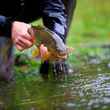











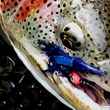




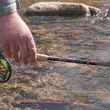





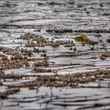

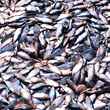
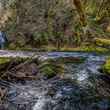
Comments